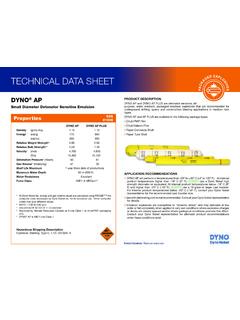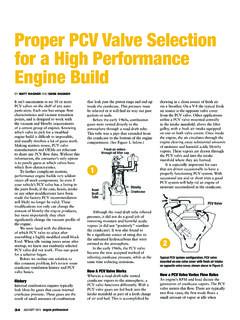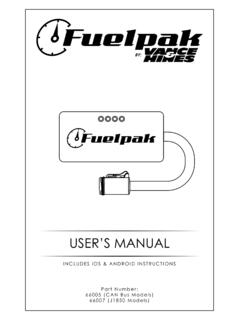Transcription of Explosives Engineers’ Guide - Dyno Nobel
1 Explosives Engineers GuideDISCLAIMERThe explosive products discussed in this document should only be handled by persons with the appropriate technical skills, training and licences. While dyno Nobel has made every effort to ensure the information in this document is correct, every user is responsible for understanding the safe and correct use of the products. If you need specific technical advice or have any questions, you should contact your dyno Nobel representative. This information is provided without any warranty, express or implied, regarding its correctness or accuracy and, to the maximum extent permitted by law, dyno Nobel expressly disclaims any and all liability arising from the use of this document or the information contained herein. It is solely the responsibility of the user to make enquiries, obtain advice and determine the safe conditions for use of the products referred to herein and the user assumes liability for any loss, damage, expense or cost resulting from such Nobel Asia Pacific Pty Limited (ACN 003 269 010) is a subsidiary of Incitec Pivot Limited (ACN 004 080 264) Level 8, 28 Freshwater Place, Southbank VIC 3006 dyno , GROUNDBREAKING PERFORMANCE, TITAN, POWERMITE, DYNOSPLIT, FIRELINE, SANFOLD, Z-BAR, NONEL, RiGHT, RINGPRIME, PRIMACORD, PRIMALINE, TROJAN, 9000 XERO, POWERMITE PLUS & POWERMITE THERMO are registered trademarks of the dyno Nobel / Incitec Pivot Limited Group.
2 SMARTSHOT, DRIFTSHOT, DIGISHOT and BLASTWEB are registered trademarks of DetNet South Africa (Pty) Limited. BLAST HI-T, STINGER EXPLODER, STEMPAC, SUPER STARTER, DYNOSTART and DYNOTRACKER are trademarks of the dyno Nobel / Incitec Pivot Group. dyno Nobel Asia Pacific Pty Limited 2020. Reproduction without permission is strictly information provided in this brochure is confidential. It may not be disclosed to any person without the express written consent of dyno Nobel Asia Pacific Pty may only use this information if you are a customer of dyno Nobel and you have been provided with it directly by an authorised representative of dyno Nobel . dyno Nobel Asia Pacific Pty Limited 2020. Reproduction without permission is strictly Hazard AssessmentTake 5! Is the task new? Is anything different? Has anything changed since you last performed this task? If so, STOP, THINK and apply the Take 5 steps!1 Describe the task. What is the task you are about to do?
3 2 List the Hazards. What are the main hazards involved in carrying out the task?3 List the controls. What controls will you use to reduce the risk?4 Assess the risk. Use the Hazard Assessment Tool (HAT) to determine the risk after controls are Decide what is next. Apply the controls. Is it safe to proceed with the task? Are additional controls required?headline dyno Nobel Asia Pacific Pty Limited 2020. Reproduction without permission is strictly Airborne shock wave resulting from the detonation of break Rock broken beyond the limits of the last pressure The pressure which the gasses of detonation exert on the blasthole The distance between adjacent weight The amount of explosive charge in charge A continuous charge of Explosives in a diameter The minimum diameter for propagation of a stable A portion of an explosive column that has failed to detonate due to rock The use of explosive products having smaller volume than the volume of the blasthole it occupies.
4 Delay blasting The use of delay detonators or connectors to separate charges by a defined Mass per unit pressure The pressure created in the reaction zone of a detonating Any chemical or mixture of chemicals that can react to produce an face A rock surface that provides the rock with room to expand when Rock that is propelled through air from a Measure to describe the size of distribution of broken rock after vibration Ground movement caused by the stress waves emanating from a The act of detonating Explosives by any drilling A method of overbreak control which uses a series of closely spaced holes that are not density The weight of Explosives per metre of Instantaneous Charge (MIC) Mass of explosive detonating in some defined time period, usually 8 Excessive breakage of rock beyond the desired excavation velocity The speed of movement in a given direction of a rock or soil A controlled blast in which decoupled charges are fired in holes on the perimeter of the excavation prior to the main Bulk Strength (RBS) The energy yield per unit volume of an explosive compared to Weight Strength (RWS) The energy yield per unit mass of an explosive compared to The distance between blastholes in the same Inert material used to confine the gasses generated during factor The ratio of the volume of broken rock to the volume of in-situ of Detonation (VoD) The velocity at which a detonation progresses through an dyno Nobel Asia Pacific Pty Limited 2020.
5 Reproduction without permission is strictly design terminology and formulasHole length (L) = BH + SDCharge length (C) = L SLBlast volume (V) = B x S x BH x NBlasted tonnes (T) = V x Density of rock in t/m3 Volume of blasthole (Vb) = x D2/4000 x LMass of explosive per hole (kg) = Volume of hole length charged x Explosive densityPF (kg/m3) = Total Explosives in the blast/blast volumePF (kg/t) = Total Explosives in the blast/blasted tonnesRWS = AWS of explosive/AWS of ANFO x 100 RBS = (RWS explosive x explosive density)/(ANFO density)Energy factor = PF x RWSV ertical length of angled holes = Measured hole length x cos Bench Height(BH)FloorHole Length (L)Subdrill (SD)Toe BurdenTo eFace Angle (FA)Free Face(C)ExplosiveColumnHeightStem Height (SL)Drilled Burden (B)Drilled Spacing (S)Hole Diameter (D)BackbreakNew Crest(After Mucking)Crest BurdenCrest = Angle subtended from the vertical by the inclined hole = (the ratio of the circumference of a circle to its diameter)AWS = Absolute weight strengthB = Drilled burden (m)BH = Bench height (m)C = Explosive column height or charge length (m) D = Hole diameter in millimetresL = Hole length (m)N = Number of holes in a blastPF = Powder factorRBS = Relative bulk strengthRWS = Relative weight strengthS = Drilled spacing (m)SD = Subdrill (m)SL = Stemming length (m)T = Blasted tonnesV = Blast volume (m3) dyno Nobel Asia Pacific Pty Limited 2020.
6 Reproduction without permission is strictly rules provide a first estimate in the absence of any better diameter in mm 15 x Bench height (BH) in metresBench height (BH) in metres (Blasthole diameter (D) in mm)/15 Burden (B) = (25 to 40) x (D)Spacing (S) = x B (This gives an equilateral pattern)Subdrill = (3 to 15) x DCharge length (C) 20 DStemming 20 x D or ( ) x BBurden stiffness ratio = BH/B : 2 to good fragmentation : > very good fragmentationStemming material size = D/10 to D/20 (Angular material with minimum fines)Presplit blastingSpacing = Hole diameter x 12 Burden = x production blast burden (B)Uncharged length at top = 10 x DPowder factor = per square metre of faceDo not stem all holes on the same delay, or in groups of 5 holesSmooth blastingSpacing = 15 x Hole diameter (hard rock) 20 x Hole diameter (soft rock)Burden = x SpacingFire as many holes as possible on one delay.
7 Stem factors Rules of thumbTypical powder factors used in mass blastsRock type PF (kg/m3)Hard Soft powder factors used in presplit and smooth blastingHole diameter PF (kg/m2)Hard dyno Nobel Asia Pacific Pty Limited 2020. Reproduction without permission is strictly burdensCrest Burden (CB) = Distance blasthole collar is from crestVertical Stemming Length (VSL) = ( measured stemming length x cos [HA] )Toe Burden (TB) = Burden at floor level = ( [tan (FA) x bench height] + CB ) ( tan [HA] x bench height )Angle faced holesVertical Stemming Length (VSL)Crest Burden (CB)Hole Angle (HA)Face Angle (FA)Toe Burden (TB)headline dyno Nobel Asia Pacific Pty Limited 2020. Reproduction without permission is strictly tableCUBIC METRES OF ROCK PER METRE OF BLASTHOLEHOLE BURDEN SPACING(Metres) (Metres)
8
9 : Tonnes of rock blasted can be calculated by multiplying the volume of rock by the density of the Cubic metres of rock per metre of blasthole (V) = burden (B) x spacing (S) dyno Nobel Asia Pacific Pty Limited 2020.
10 Reproduction without permission is strictly density Hole Diameter Kg of explosive per meter of column for given density (g/cm3)* Hole Diameter mm in mm in 25 1 25 1 32 1 1/4 32 1 1/4 38 1 1/2





